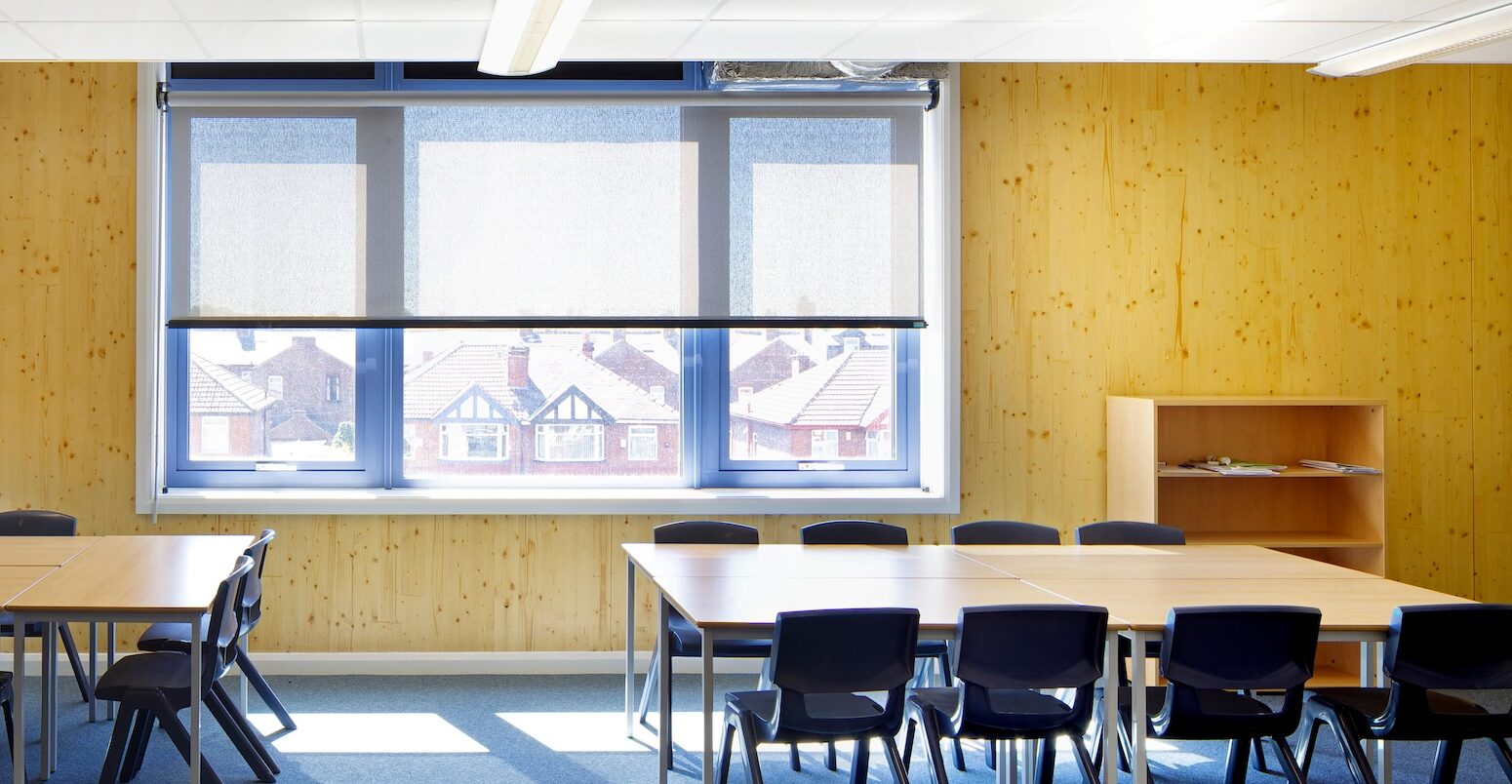
English schools face ‘overheating’ for one-third of year under 2C warming
Ayesha Tandon
05.14.24Ayesha Tandon
14.05.2024 | 9:48amEnglish schools could exceed an “overheating” threshold of 26C for one-third of the academic year if global warming reaches 2C above pre-industrial temperatures, a new study finds.
The study, published in Climate Risk Management, assesses the risk of overheating in around 20,000 schools across England, using data on the schools’ location, the type of building and the climate.
The authors identify the indoor temperature of 26C as the upper “comfortable” limit in classrooms. While the average school would be expected to surpass this limit for more than one-third of the academic year under 2C of warming, it rises to half of the year for 4C of warming.
The authors also investigate a 35C threshold, above which “important health impacts” are seen. They find that, currently, schools only exceed this temperature threshold once every year, on average.
However, under 4C warming, the average school is expected to exceed this threshold around nine times per year, accounting for 5% of the academic year.
Newer schools are more likely to overheat than their older counterparts, the authors say, because they typically have better insulation and lower ceilings. They add that schools in the south and east of England, as well as London, are at greatest risk of overheating.
The study shows the need for adaptation measures such as improved ventilation, a scientist not involved in the study tells Carbon Brief. She adds that “school buildings need to be designed today with tomorrow’s climate in mind”.
Overheating schools
Over the past month, millions of children in the Philippines, Bangladesh and India stayed home as a record-breaking heatwave forced schools across southern Asia to shut.
However, schools in more temperate climates can also be affected by the heat. In July 2022, the UK experienced a record-breaking heatwave that saw temperatures exceed 40C for the first time on record. During this period, the UK put out its first red heat alert and many schools finished early or closed their doors entirely for the safety of their staff and students.
Extreme heat can be deadly. During a heatwave, the number of “heat-related deaths” – where exposure to heat either causes or significantly contributes to a death – tends to increase.
Children are particularly vulnerable to high temperatures. When it is hot, the human body produces sweat to cool itself down. However, children do not sweat as much as adults and are therefore less able to regulate their body temperature.
Even when temperatures do not reach headline-grabbing highs, any increase above the “optimal” temperature can be harmful. A recent World Bank report estimates that in “middle and high-income settings”, the ideal classroom temperature lies between 19.5C and 23.3C. The report says:
“In those settings, any temperature above 24C can compromise reaction time, processing speed and accuracy through changes in heart rate and respiratory rates…
“Across five experimental studies, high temperature produced declines in student performance ranging from 2 to 12% for each 1C increase in classroom temperature.”
Furthermore, when teachers work in classrooms that are too hot, they can become fatigued or lose concentration, making them more likely to put themselves and the children in their care at risk.
UK guidance suggests a minimum working temperature of 16C, if employees are not carrying out physical work. However, there are no legal maximum working temperatures for schools in the UK.
“Our children spend 30% of their lives in schools,” says Prof Lucelia Rodrigues – chair of sustainable and resilient cities at the University of Nottingham. Rodrigues, who was not involved in the study, tells Carbon Brief that it is “imperative that we provide them with comfortable, healthy environments to thrive and achieve their best”.
Newer buildings
The new study assesses how often English schools overheat, which schools are most at risk and how climate change could exacerbate the problem. The study authors define two temperature thresholds:
- 26C: The “upper limit of comfortable operative temperature in schools”.
- 35C: The temperature at which “important health impacts” are seen.
The authors use the open-access CLIMADA platform to simulate the risk of English schools overheating, combining information on hazard, exposure and vulnerability.
The authors use climate data from the UK Climate Projections 2018 (UKCP18) to determine annual variations in temperature across England over 1998-2017. They then model those temperatures in worlds with average global temperatures of 2C and 4C above pre-industrial levels. This provides the hazard data.
They then quantify exposure using data on the location of around 20,000 primary and secondary state schools in England. And vulnerability is assessed using “physics-based building models” to quantify the link between outdoor and indoor temperature for different types of buildings.
The plot below shows an example of the relationship between outdoor daily average temperature (blue) and indoors daily maximum temperature (red) in two different schools. The dashed and dotted lines indicate the 26C and 35C temperature thresholds, respectively.

The authors find that schools built before 1918 are generally most able to keep cool, while those built after 1967 overheat the most easily.
Dr Laura Dawkins – an “expert scientist” in climate risk and resilience at the UK Met Office, and lead author of the study – tells Carbon Brief that this is due to “differences in typical floor-to-ceiling heights”. Newer schools are typically built with lower ceilings, which cause the room to heat up more quickly, she explains.
Rodrigues adds that newer schools are built to “more stringent building regulations designed to reduce heating energy demand”, making them more airtight and well-insulated. Citing her 2010 study, she continues:
“In classrooms within schools built post-2010, overheating occurred for more than 40% of school hours, whilst in older schools with leakier and non-insulated envelopes overheating was rarely reported.”
Rodrigues says that ventilation is key, noting that it not only prevents buildings from overheating, but can also “improve air quality, which will have a significant impact on productivity” in pupils.
Mapping heat
The study’s findings include a series of maps to show where the most at-risk schools are located.
The maps below show the expected total number of days in an academic year that each school will cross the 26C (left) and 35C (right) temperature thresholds. The top row uses the climate of 1998-2017, the middle row a 2C-warmer world and the bottom row a 4C-warmer world. Darker red indicates more overheating days.
The authors assume 195 days in a school year, to account for weekends and holidays. The analysis does not include August – the hottest part of the year – because schools are typically closed for the summer holidays during this time.

The authors find that schools in south and east of England, as well as London, are at greatest risk of overheating. They add that this is largely due to the urban heat island effect – in which a combination of factors, such as buildings, reduced vegetation and high domestic energy use, cause urban areas to become hotter than more rural regions.
By combining the data from all 20,000 schools, the authors determine how many days the average school is expected to cross the 26C and 35C warming thresholds under different global warming levels. The authors also calculate values for “at-risk” schools – which rank in the highest 10% on their risk metric.
These results are shown in the table below.
| 26C threshold, average school | 26C threshold, at-risk school | 35C threshold, average school | 35C threshold, at-risk school | |
|---|---|---|---|---|
| Recent climate | 59 | 59 | 1 | 1 |
| 2C warming | 71 | 75 | 3 | 5 |
| 4C warming | 89 | 92 | 9 | 13 |
The average school currently exceeds the 26C threshold for 59 days – accounting for around one-third of the academic year – according to the study. However, the authors warn that this could rise to 71 and 89 days under the 2C and 4C scenarios, respectively.
Meanwhile, England’s most at-risk schools currently face one day per year of indoor temperatures above 35C. This could rise to five days per year under a 2C warming scenario, and 13 under a 4C scenario.
This study is “a first attempt at applying the novel spatial risk assessment framework to this real world problem”, according to Dr Dan Bernie climate resilience science manager and health science lead at the UK Met Office and an author on the study.
Bernie tells Carbon Brief that he is currently working on “generating more robust results using individual school building models and higher resolution climate projections”.
Prof David Bresch is a professor at the department of environmental systems science at ETH Zurich and is the founder and senior scientific advisor at CLIMADA. He tells Carbon Brief that the authors have used the platform well, providing a good “prototype” for this type of study.
The biggest “challenge” in the study is the team’s use of fixed temperature thresholds, he says. However, he calls the paper an “important contribution” to the literature, and says that it will allow schools and governments to start thinking about adaptation measures.
Bresch emphasises the importance of adaptation. He tells Carbon Brief that it is crucial to “take a forward looking view of risk”, adding that it comes with the win-win situation of limiting impacts and likely coming with a lower price tag than waiting for major impacts to hit.
Government plans
Every five years, the UK government publishes its Climate Change Risk Assessment (CCRA), which assesses the “current and future risks to and opportunities for the UK from climate change”.
The National Adaptation Programme (NAP) is published shortly afterwards, allowing administrations such as the Department of Education (DfE) to outline how they are planning to adapt to climate change.
In July 2023, the UK government published its third National Adaptation Programme (NAP3). In this report, the DfE recognised the “significant threat” of rising overheating in schools, and highlighted the need for further research to better understand this risk.
The new study was carried out partly in response to this call for research and has experts from both the UK Met Office and DfE in its author list. Bernie tells Carbon Brief that this study was a collaboration between “climate science, data science, building performance models and stakeholder insights”.
The DfE tells Carbon Brief that it has already allocated £138m to make education buildings more sustainable or more resilient to the impacts of climate change. The UK government’s “strategy for the education and children’s services systems” adds:
“All new school buildings delivered by DfE (not already contracted) will be net-zero in operation. They will be designed for a 2C rise in average global temperatures and future-proofed for a 4C rise, to adapt to the risks of climate change, including increased flooding and higher indoor temperatures.”
However, Rodrigues tells Carbon Brief that “there is still no requirement to design for future climate conditions, even though schools typically have at least a 50-year lifespan, with many occupied continuously for over 100 years”. She adds that “school buildings need to be designed today with tomorrow’s climate in mind”.
The DfE tells Carbon Brief that they are working with partners including the Met Office on the next iteration of this research and will provide more information about it later this year.
Dawkins. B. et al. (2024), Quantifying overheating risk in English schools: A spatially coherent climate risk assessment, Climate Risk Management, doi:10.1016/j.crm.2024.100602
-
English schools face ‘overheating’ for one-third of year under 2C warming





